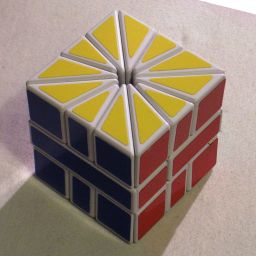


The Square-2 puzzle is a cube that consists of three layers. The top and bottom layers are
cut radially like a pie into 12 parts, each 30 degrees wide. Some of the cuts go through the
vertices of the square, so along each side of a square outer layer there are three pieces.
The middle layer has a single cut from the front left to the back right, separating it into
just two pieces. You can rotate the top or bottom face any multiple of 30 degrees, and you can
twist one half of the puzzle along the middle layer cut which exchanges 6 pieces from the top
layer with those on the bottom layer. The puzzle is stickered so that each face of the cube is
a different colour.
This puzzle is essentially an unbandaged version of the Square-1 puzzle, and was first
made by David Litwin.
There are two mechanisms for this puzzle. The first mechanism was based directly on the Square-1 where the pieces are slotted onto a fixed rail attached to the middle layers. The improved mechanism has springs that make it less rigid, smoother, and much more forgiving to minor misalignments.
We will use one of the middle layer halves as our reference point. The other half can be can be correct or flipped, so has 2 possible states. The 24 pieces in the top and bottom layers are all different, and so can have at most 24! possible arrangements. This gives a maximum of 2·24! = 1,240,896,803,466,478,878,720,000 positions. All these are actually achievable. Note that there are two solved positions, as it is possible to swap the top and bottom face colours.
Hold the puzzle with the "Square-2" logo on the left. This left half remains fixed and serves as a reference point. Twisting the right hand side of the puzzle by a half turn is denoted by the letter R. A clockwise turn of the top layer by one piece (30 degrees, 1/12 of a turn) is denoted U, and similarly a clockwise turn of the bottom layer is denoted D. Anti-clockwise turns are denoted by U' and D'. The letter can also be followed by a number to indicate how far to turn, for example U6 is a half turn of the top layer.
Phase 1: Solve the bottom and middle layer.
Phase 2: Solve the top layer.
The top layer will be solved by only swapping adjacent pieces. By repeatedly swapping one
particular piece with whatever piece is to its right, you can move that piece all around the top
layer until it is in the spot you want.
Neat move sequences: